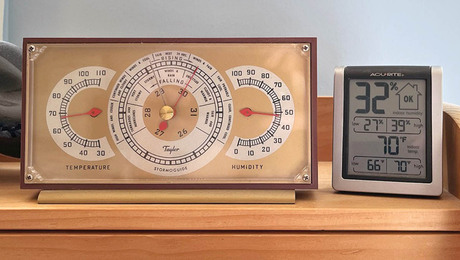1890’s vintage basement floor refinish

Hi,
I’ve a 1890’s vintage house in south central Wisconsin with a stone/rubble foundation and a horribly cracked concrete basement floor. Since we bought the house two years ago and had gutters put up, there has been no large water leaks in the basement, but the floor sometimes feels damp in areas where the concrete has cracked and/or disappeared to the soil below. The basement is about 2/3’s proper basement, and then opens to a small crawl space under one portion of the house (the other 1/3). I’d like to rip out the concrete floor of the basement, dig out a few inches of the soil and repour the floor so it is level and solid. Any suggestions on addressing moisture in the basement if the opportunity is there to do something with the floor ripped up? I’ve thought about adding a sump / drain tile around the perimeter. Curious also if this is silly given the crawl space being there.
Thanks


















Replies
A bunch of things come to mind. Given that the foundation walls are somewhat damp-proofed and sitting on decent footings, replacing the floor with a 10 mil poly moisture barrier under a 4 inch concrete slab will prevent moisture in the ground from coming up through the floor.
If the foundations walls leak, you have a much bigger problem. won't get into that in this thread.
Often vintage homes are not sitting on footings. The foundation walls are just sitting on the ground. When you dig up the old floor, be careful not to undermine the walls. Or go all the way and put footings under the walls, another big job.
Your mention of how the downspout repair improved conditions in the basement leads me to believe that excessive moisture in the soil was causing some of the problems. Improving perimeter drains and rain water leaders will go a long way to keeping things dry down there. Again, older homes present some difficulties in that the perimeter drain, probably clay tile, is likely filled with roots and mud. It is a big job to dig up the perimeter drain, but it is pretty standard procedure for homes more that 30 or 40 years old up here in Victoria, Canada.
Directing rain water away from the house ie. hooking the new downspouts up to new subsurface tight pipe drains, needs to be part of the solution.
I don't know what you have in your budget, but if you can afford an engineer to look at it before you begin, thats the way I would go. Old stone foundations are prone to extreme problems. If you get the go-ahead, put in the foundation drain while you have every thing open. Stone base, filter cloth, drain tile or pipe, more stone on top of tile, wrap filter cloth around, vapor barrier, wire mesh and concrete. Luck.
Thanks - the foundation is pretty solid for being over one hundred years old. Not really any cracks, bulging, etc., just some of the mortar spalling (sp??) and falling off. I agree with what you're saying - but where should the drain tile/pipe run to? A sump, or does having the stone underneath provide the proper place for water to run to? Also, any recommendations on putting a floor drain?
Unless your basement is above your outside grade you will need a sump+pump. You can't let water in your basement unless it has somewhere to go. You can put a floor drain in anywhere you want, tie it into your sump, you don't need a trap because it is not connected to the sanitary system. If you decide to go this route, make sure that the discharge slope of the sump pump is away from the house. Luck.
I agree with the others about the vapor barrier under the concrete. I have a similar type and age house. I ran a drain pipe in gravel in a loop under the slab and kept the drain trench at least 2 ft off the walls to not disturb the bearing soil of the walls. Try to pipe the sump well away from the house, preferable to a point of day light sloping away from the house. Use a check valve in the sump line.
Thanks Shacko and Norse - I take it there may some code considerations with routing the sump discharge to the sanitary sewer. How do you make the discharge pipe look nice coming out of the house? The foundation above grade up to ~2 feet is limestone block, so the way out of the house is above this. The AC unit (another vintage behemoth) has pipes coming into/out off one of the basement windows. I guess I could follow that route, which would take me the side of the house that slopes down & away from mine (to my neighbours house....oops). Oh well, guess he should clean up his dog crap more frequently, then I might feel guiltier. Actually shouldn't be an issue if the sump runs infrequently right? In a heavy downpour there is already three downspouts from the gutters running his way and I having heard a complaint yet. But if there is a way to make it look pretty my wife might let me progress to bigger and better projects without getting the evil eye every time.
This is my first time posting here and think this is great. My wife got me a subscription to Fine Homebuilding for Valentines - what a trade for a box of chocolates eh?
>>"My wife got me a subscription to Fine Homebuilding for Valentines"
Uh oh, you got it bad now. FHB subscription . . . first one is free then once you're hooked . . . . I think I renewed mine for the next nine years or something. Can't shake it once you start ;-)
"A job well done is its own reward. Now would you prefer to make the final payment by cash, check or Master Card?"
Sounds like you've got a plan. My basement is only 6' high and the pipes are below that. Working down there was a hard hat zone.
When you day light the pipe or where your down spouts dischagre, dig a small area out (2' x 2' x 6" to 1' deep) and fill it with gravel and maybe some larger stones on top of the gravel and perhaps some plants around the pit. A mini dry-well of sorts. This will disipate the energy from your water heading towards your neighbor and at least show that you've made an effort towards good relations. I recently helped a friend trench and pipe all of his downspouts to the public sidewalk because his downhill neighbor also had water problems.
Welcome to Breaktime!
Norse
Good replys.
Did this same thing once. Wall was not sitting on footing just dirt. The poored concrete floor was put down with gravity, just poor it in. Hit concrete 1 inch thick in one area, in another it was 16 inches thick. The entire 20 tons of concrete and dirt was hauled out in 5 gallon pails. Was careful not to undermine the rock wall and poored a short formed kneewall around the perimeter that re-anchored the rock wall and gave us a few more inches of badly needed head room. Turned out great though but what a job.
Generally--
Likely the existing floor is quite thin -- 1 or 2 inches thick in places.
Excavate enough soil to even things up a bit and regain the height you'll lose by pouring a thicker slab. But if you go too far you'll undermine the foundation, so limit it to a few inches.
Perimeter tile and a sump is a good idea. Don't try to get too close to the "footing", though, to avoid undermining it. Check with AHJ -- legally you'd need a vent in the sump, but they may give you a pass.
Plastic under the slab is a good idea to, but not manditory. You aren't going to be able to use this for habitable space, really, and anything stored should be kept off the floor a few inches on general principles.
I'd put a hole through the foundation for the pump output, if reasonably possible. But I haven't seen the foundation.
Check with you AHJ generally, to make sure there are no other code or permit issues involved here.
happy?
I just had the local rep for a basement waterproofing company here to work up an estimate. I'm not going to name the company, but they are a national chain with thier own patented "system". Interested to see the cost they may charge, but the solution the rep talked about did not seem as thorough as what the posts here have been (i.e. I don't think they would but a new underlay of gravel/stone under the new concrete, and when I asked about a vapor barrier under the concrete I got a funny look). Guess the system must be something. Nice dehumidifier product though, if you believe the literature.......
Most of those "systems" involve a hollow plastic baseboard installed around the outside wall. It collects water from holes drilled into the wall and routes it to a sump. Probably they also include some sort of waterproofing coating on the walls.
If ignorance is bliss why aren't more people
happy?
Got the quote back from the basement people. >$17K for the whole job; removal of old concrete, add drain tile around perimeter, sump pump, three new basement windows, large dehumidifier, and covering/vapor barrier in the crawlspace. Nice enough to break out the costs abit, so the concrete work looked like ~$3.5K, which is the part I'd have the hardest part doing myself. I'm thinking that digging out old and installing the tile, sump etc. is doable myself, just hard work w/ 5gal buckets and shovel. Windows - I've already replaced one so I can do the other 3 for less than $400/per. Now I just need to find a concrete contractor and see if he'd pour the floor and how much it would cost.
If building a new house, is it typically the concrete contractor that installs the drain tile, build/forms the sump, etc., or does he jsut back the cement truck up and unload?